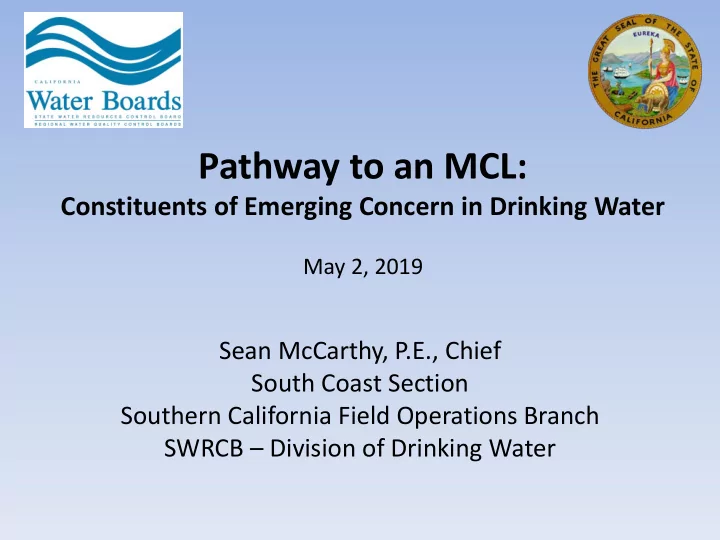

Pathway to an MCL: Constituents of Emerging Concern in Drinking Water May 2, 2019 Sean McCarthy, P.E., Chief South Coast Section Southern California Field Operations Branch SWRCB – Division of Drinking Water
CA Division of Drinking Water • Transferred to SWRCB July 1, 2014 from CDPH • Maintain public health focus on drinking water constituents • 2 Field Operations Branches – 24 District Offices and 30 County LPAs – Regulatory oversight of 7,500 public water systems • Program Management Branch – Regulatory Development Unit – Quality Assurance Section 2
MCL Adoption Process • Constituent of public health concern – Public health goal, USEPA MCL, WHO, other states • Occurrence in CA drinking water – Title 22 monitoring, UCMR monitoring • Evaluates technological and economical feasibility • Public review • Board Adoption and Office of Administrative Law approval 3
Constituents of Public Health Concern • Maximum Contaminant Level (MCL) – Maximum permissible level in drinking water § 116275(f) CHSC – Primary (health-based) and secondary (aesthetic) • Set as close as feasible to Public Health Goal (PHG) placing primary emphasis on protection of public health – Technologically and economically feasible 4
Public Health Goals & Notification Levels • PHGs are established by Office of Environmental Health Hazard Assessment (OEHHA) – Level that does not pose a significant risk to health – Considers relevant scientific information from USEPA, ATSDR, NIH – 1x10 -6 Lifetime cancer risk – Health protective concentration for non-cancer risk – 91 Public Health Goals for drinking water 5
Public Health Goals & Notification Levels • Notification Levels (NL) are established by SWRCB Division of Drinking Water – Public Health Goal or OEHHA recommendations – May respond to draft PHGs, EPA Health Advisory Levels – Perfluorinated chemicals (PFASs) – 2018 • Notification Levels are not enforceable; however state law… – Requires notification to governing body if NL exceeded – Recommends removal of source if 10 or 100 times NL 6
Public Health Goals & MCLs • Division of Drinking Water will request OEHHA to develop a Public Health Goal prior to initiating a formal rulemaking on an MCL. – 1,4-dioxane – Trihalomethanes • Development of a PHG takes 1-2 years 7
Occurrence Data • How many sources/water systems have detections? • What is population affected? • Initial round of monitoring needed – UCMR (EPA), Title 22 or other • PFASs monitoring orders – 640 sources statewide, high risk of contamination • UCMR detects • Landfills • Airports using firefighting foams 8
Technological and Economic Feasibility • Analytical Methods – EPA approved drinking water method – 1,2,3-TCP needed CA approved method • Treatment needed remove constituent from water – Best Available Technologies have not been identified • Economic Impact of MCL – Hexavalent chromium will be re-evaluated 9
Review of Existing MCLs • Health and Safety Code §116365 – Review existing MCLs at least every 5 years – By March 1, notice each standard or MCL under review that year • Consider changes in treatment technology • New scientific evidence of a greater health risk – Public Health Goal – Greater occurrence in monitoring 10
1,2,3-TCP Maximum Contaminant Level (1,2,3-Trichloropropane) • MCL 5 ng/L – Effective January 1, 2018 • Public Health Goal (PHG) established 2009 – 0.7 ng/L (parts per trillion) • Synthetic organic chemical (SOC) – Industrial solvent, degreaser – Ingredient in soil fumigants widely used for many decades • GAC is a best available technology • Blending difficult with DLR = MCL 11
Perchlorate MCL Revision • Revised Public Health Goal of 1 ug/L (2015). • Current detection level for reporting (DLR) is 4 ug/L. • July 2017 Decision to initiate two-step process for revising perchlorate MCL 1. Amend Title 22 regulations to lower DLR 2. Gather occurrence data below 4 ug/L for use in future MCL revision 12
Perfluorinated Chemicals • Emerging constituents in drinking water from EPAs UCMR3 monitoring (2014-15) • Man-made, does not breakdown easily • Found in many consumer products, ex. cookware, food packaging, stain repellants, fire retardants • EPA set initial Health Advisory Level (Oct 2016) – 70 ppt (PFOA + PFOS) – Lifetime exposure – Reproductive, developmental health effects 13
Perfluorinated Chemicals • CA DDW Notification Level (July 13, 2018) PFOA: 14 ppt PFOS: 13 ppt – Confirmed detection in water delivered to public requires notification to the governing body(s) of the local agencies in the service area of the public water system • Response level: 70 ppt (each or combined) – Recommends additional steps beyond notification to reduce exposure – Treatment or remove source from service 14
Other Emerging Constituents • Lead DLR revision • Microplastics – Definition and analytical method needed • Cyanotoxins – Harmful algal blooms – UCMR 4 monitoring in surface water supplies – Optimization of surface water treatment plants • Pharmaceuticals and Endocrine Disruptors (CECs) – Recycled Water, Potable Reuse 15
Contact Information DDW Regulatory Development Unit Melissa Hall Melissa.hall@waterboards.ca.gov https://www.waterboards.ca.gov/drinking_water/programs/ Subscribe to “Drinking Water” Email Lists https://www.waterboards.ca.gov/resources/email_subscriptions/ 16
Questions? Sean McCarthy Sean.McCarthy@waterboards.ca.gov (909) 388-2602 17
Recommend
More recommend